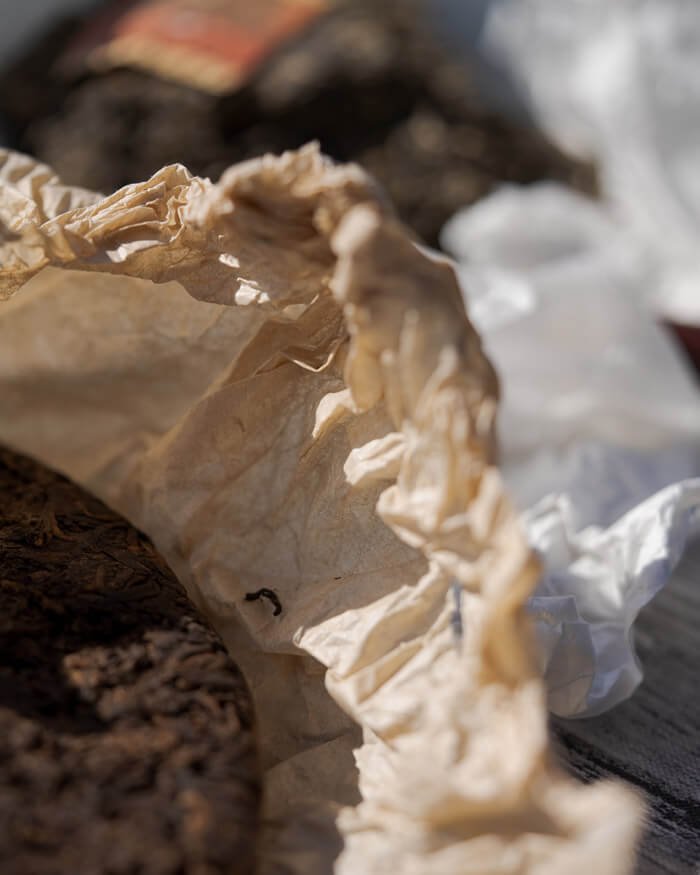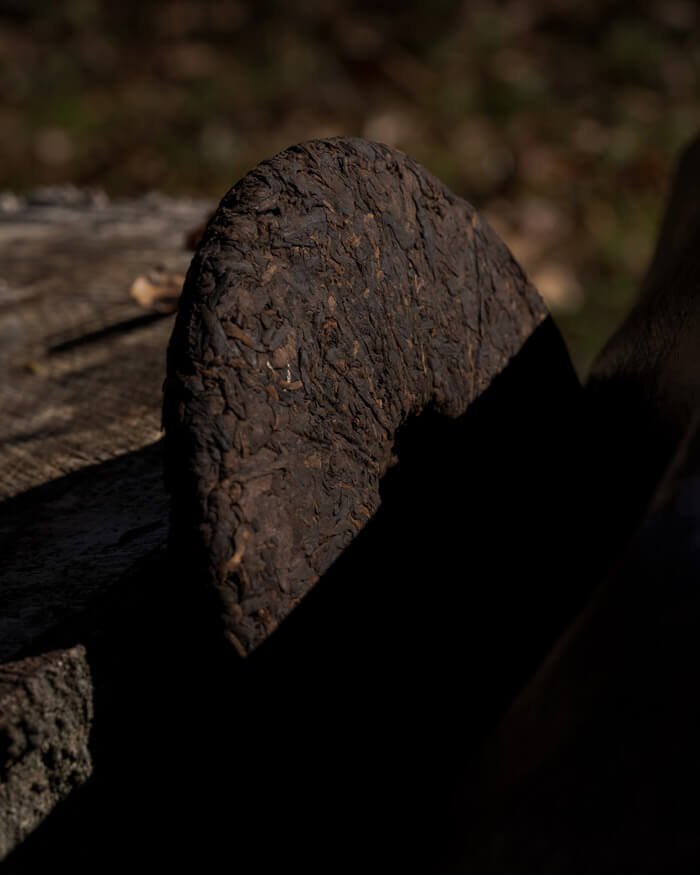The Story Behind Shou Pu Fermentation (Ripe Pu Er)
Pu Er is a unique style of tea that uses passive or active fermentation to achieve its softened, earthy notes. Whenever I’ve spoken to my tea friends about Pu Er, there’s always been a few unanswered questions I’ve had:
Exactly what kind of micro-organisms create Shou Pu Er?
Does Ripe Pu Er have more caffeine than other teas?
What exactly changes in the tea to go from green tea to Shou Pu Er?
This article is a bit more intermediate than other articles on the Ooika blog. So I’d recommend giving our “what is a Pu Er cake” article a read first. But if you like Pu Er (especially Shou Pu), or just like to nerd out with tea you’re going to be fascinated by this article like I was.
A quick Refresher on Pu Er
It’s probably helpful to touch on a few points before we get into the science. While we describe other teas as being fermented (such as white tea, red tea etc…) we’re really talking about enzymatic metabolism, not microbial metabolism like in with bread, kombucha, kimchi, etc. Pu Er is not a category of tea, it’s just a style of tea that must come from Yun Nan Province, China.
In the Pu Er style, there are 2 subcategories:
Sheng Pu - “Raw Pu Er”, which is made from green tea that naturally matures over time due primarily to enzymatic activity (not microbial fermentation.)
Shou Pu “Cooked Pu Er”, which is also made from green tea but is stacked in large piles, covered and moistened which composts and breaks down the tea.
Quick Note: One of the 6 categories of Chinese tea is “Black tea” (Hei Cha), not to be confused with what we call “black tea” in the west, which is actually Chinese Red Tea (Hong Cha.)
Shou Pu is considered a Black Tea (Hei Cha) - but Sheng Pu is considered a Green tea.
This is why we consider Pu Er not to be a category of tea, but rather, a style of tea that comes from one particular region -- Yun Nan.
Anyway, let’s get into the meat of the tea cake now.
Here are 4 facts about Fermentation and Caffeine in Shou Pu.
The Primary Microbe Responsible for Shou Pu is a Fungus called Aspergillus Niger
To make Shou Pu, the leaves are piled up, wetted, and covered. This warm and moist environment encourages microbial growth to break down the tea leaves giving us the soft, bittersweet, and earthy aroma that Shou Pu is famous for. The most common microbes that grow during this composting process are:
Aspergillus niger.
Penicillium,
Rhizopus
Aspergillus glaucus
Yeast
Aspergillus niger is the most dominant microorganism, accounting for 80%.
Getting to Know Aspergillus Niger in Ripe Pu Er
You might not have heard the name Aspergillus Niger before but you’ve definitely encountered it. It’s the black mold that can grow on foods such as fruit and vegetables. It’s very common in any kind of stored food item such as nuts, and even in dried and smoked fish/meat. And… some strains of A. Niger can produce a mycotoxin known as ochratoxin A.
As the name “mycotoxin” suggests, this is not a healthy thing to ingest and can cause you to have allergies or become ill. Luckily, in the case of Shou Pu, the Fungus does not produce toxins and is in fact very healthy (more on this later) — assuming the Shou Pu is made correctly. (This is why it’s so important to get your Shou Pu from a trusted source.)
It’s really not Scary
Aspergillus Niger is actually used in a lot of food and biotechnology so it being the “happy accident” of Shou Pu isn’t all that surprising.
In fact, it’s used to create extracellular food enzymes, citric acid and more, thus A. Niger is thus considered a safe production microorganism and this is definitely the case in tea! Plus, it’s resistant to space radiation, so you know, that’s cool...
Fungus Fermentation Changes the Chemical Nature of Pu Er
Fungus (and other microorganisms) change Pu Er. The question is how -- and what is being changed. Well, the answer here blew me away - there’s a broad network of changes in Pu Er that occur during fermentation, including:
Degradation - The Chemical process of breaking down and simplifying complex chemicals into simpler ones.
Isomerism - Changing the shape of a cluster of atoms (without adding or removing any), thus creating a new compound with different properties.
Coupling - Combining fragment molecules together via a catalyst.
Polymerization - Bonding of similar compounds into a longer chain.
All of this is just to say: the fungus changes stuff chemically. That new stuff is different from the old stuff - and when done properly by a skilled tea artisan, greats a better product.
What Exactly Changes?
When it comes to Cooked Pu Er, one of the biggest changes in mouthfeel is astringency. Cooked Pu is particularly smooth when compared to a young Sheng Pu. It turns out that it is because the fermentation process rapidly alters tea polyphenols.
What are Tea Polyphenols? Tea Polyphenols are plant antioxidants found in the Camellia Sinensis tea plant. Much of the mouthfeel of tea comes from these polyphenols.
These polyphenols include catechins (a kind of flavonoids) and tannic acid (which gives your mouth that “drying” feel like after drying a dry wine.)
Polyphenols have a long and heavily documented positive effect on human health, such as staving off cancer, heart disease, and other ailments.
Without getting too nerdy or scientific, here’s the quick and simple breakdown: The Fungus in tea (and to a lesser extent, the yeasts and other life forms) use the tea polyphenols as a source of Carbon.
This breaks down (reduces) and alters the tea polyphenols in Shou Pu. These tea polyphenols are also transformed into other components that are elements in desirable Shou Pu, such as:
Gallic acid - A polyphenol found in many fruits and plants, with many documented health benefits.
Theaflavin - A reddish-orange pigment that is demerized from Catechins in tea.
Thearubigin - The Brown pigment found in Red Tea.
Polysaccharide - A plant-based carbohydrate with examples being starch, cellulose, glycogen…
And more…
Anyway, all of these compounds give Shou Pu it’s unique properties, such as:
A smooth, soft taste.
The dark brown or black color of the tea broth when you brew it.
The sweet taste that is associated with Ripe Pu.
Quick Note: Green tea has lots of astringent Catechins in it. These catechins become oxidized and turn into Theaflavin. Theaflavin is what’s responsible for red tea becoming red.
Another reason the tannic quality of Shou Pu reduces is that the tannins are hydrolyzed into organic substances that are flavorful and aromatic. The end result? The fresh, astringent, and bitter taste of unfermented tea morphs into the earthy, round taste of aged tea.
Fermentation Actually Creates Caffeine in Shou Pu… from Scratch!
All tea has caffeine, but I’ve always found that Shou Pu (and Sheng Pu) have electric levels of Caffeine. But… that doesn’t make any sense. Why? Because when it comes to tea -- the fresh young buds have the highest caffeine concentration. This is because the caffeine in tea functions as an insecticide. So the vulnerable new buds will have the greatest amount; especially spring buds, which have had an entire dormant season to gather nutrition.
That’s why teas like bud-only Bai Hao Ying Zheng (Silver Needle) will have more caffeine than Bai Mu Dan which is made from a Bud and two leaves.
By weight, there is fewer buds and more leaves, meaning less caffeine…
Despite the fact, both teas are made from the same tea bushes.
And the only difference is the sorting.
Long Story Short: the further down the branch on the tea tree you go, the less nutrients the leaves have -- that include caffeine.
If you want lower caffeine teas, go for ones that don’t have buds -- or at least, less buds.
The Creation of Caffeine
But with Pu Er, no buds are used and, in fact, some tea is made from pickings made with 4-5 leaves. Though this is usually only done with very old tea trees, with deep roots - so even lower leaves have superior nutrients.
Extra extra: Cha Geng is the name tea made from the first 4-5 leaves. While Dan Ya is tea made from buds only.
The point here is that the tea used to create Pu Er is made of only leaves and therefore should have low caffeine content. But anyone who has had a long Pu Er drinking session can tell you: they get wired.
How is it that Pu Er has so much caffeine if it’s made from leaves that have the lowest levels of caffeine?
This was always a “black hole” in my tea knowledge - never really understood what was going on here. I just knew that it seemed impossible.
The Impossibly Possible Answer
The answer is (as you guessed from the title of this section) the caffeine is actually created by the fungus. See: Theophylline is a compound in tea that’s related to Caffeine (and theobromine.) A. Niger is actually able to convert the Theophylline into caffeine itself!
Pu Ers vary in Taste Partly Because of Different Microbes
When you take a sip of tea, you get to taste the earth and sky of where it came. In one brewing session you can travel from Fujian province to Sichuan. You can experience the air, the wind, and the sea. This is what excites me so much about tea -- by heart, I’m an adventurer and traveler.
There is a French word, “Terroir.” It describes the effect the land has on a crop and this concept is widely known: a sparkling wine is only a Champagne if it is produced in Champagne.
Micro Biodiversity, too.
Until I researched for this article it never struck me that the terrior would be so heavily affected by micro biodiversity. Samples taken from different fermentation composts in different provinces such as Chongqing and Yunnan — and even from different towns in the same provinces had different fungal populations. Many of the flavors unique to individual terroirs come from, in a large part, micro biodiversity and not simply macro-environmental factors.
It Only Goes on From Here
The mysteries in fermenting Shou Pu continue on, but we’ll reach a stopping point. It is worth noting that many of the fungus and bacteria associated with wet-piling Shou Pu is also present in Sheng Pu. However microbial fermentation isn’t really a key transformational element in Sheng Pu. (If it was a primary factor, then Sheng Pu would be considered a Black tea, not a Green tea.)
But, A. Niger and others are still there, changing the nature of the tea itself. In any event, we covered (a whole LOT that I didn’t know before) including:
A Fungus called Aspergillus Niger is responsible for the bulk of changes during fermentation.
The changes in taste from Shou Pu’s come not just from the plant or climate, but also from the microorganisms during fermentation.
Caffeine is created during the wet piling process, which is why Shou Pu has more caffeine than Sheng Pu.
All pretty wild.
Since the 1970s (when the process was developed by the Kunming Tea Factory) to create Shou Pu until now, we have such a deeper understanding of tea. Which can give us a new way to appreciate and discuss the second most popular beverage in the world - next to water itself.
MORE ON CHINESE TEA


















